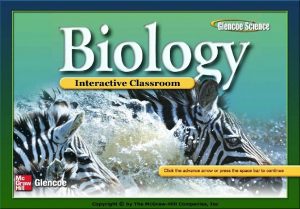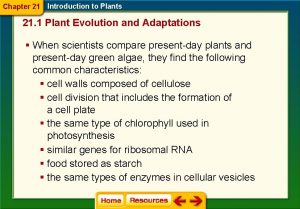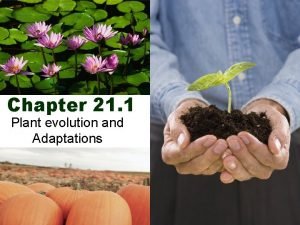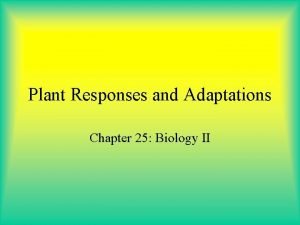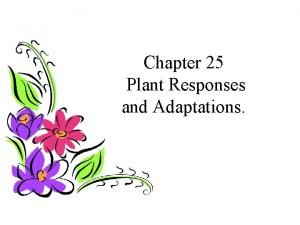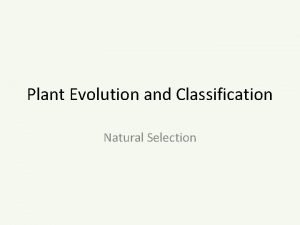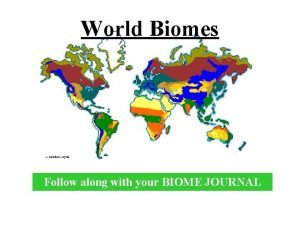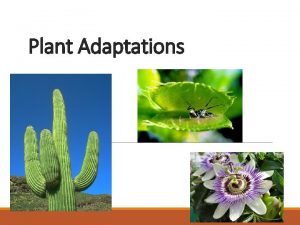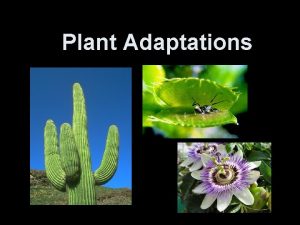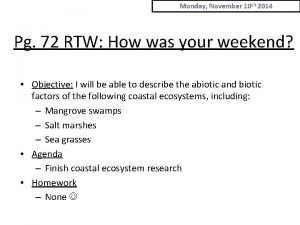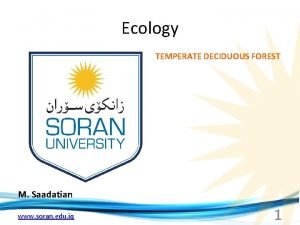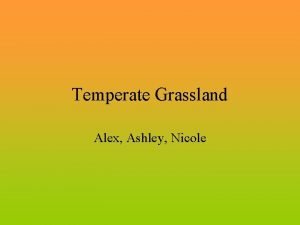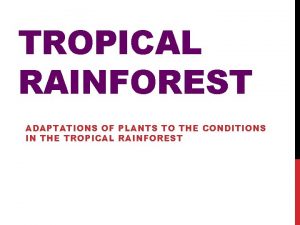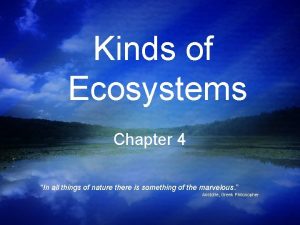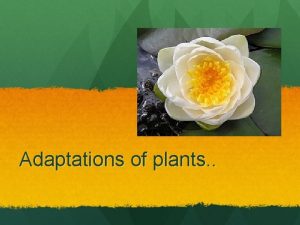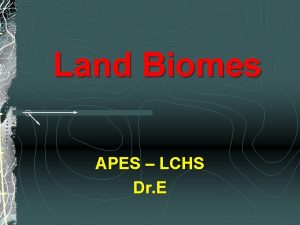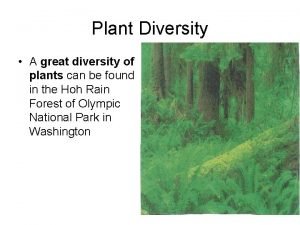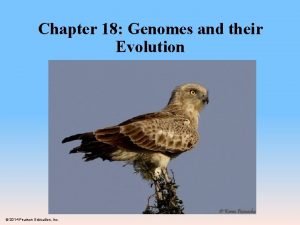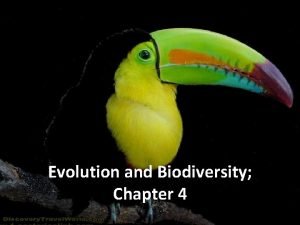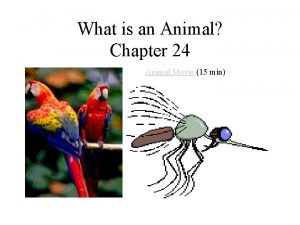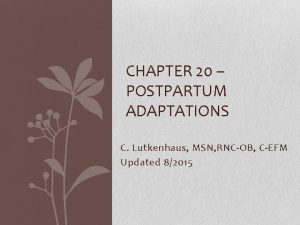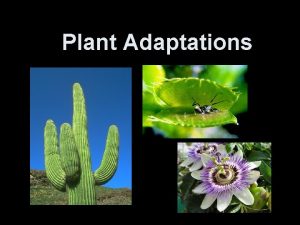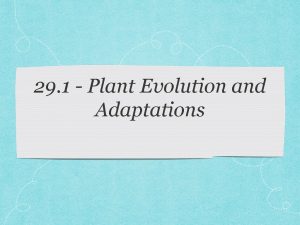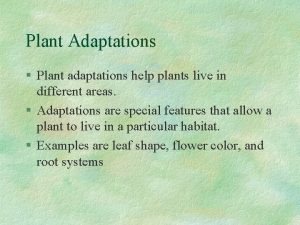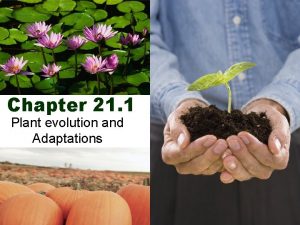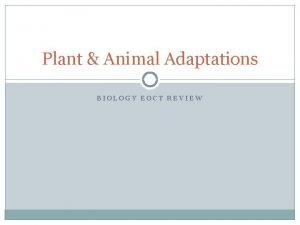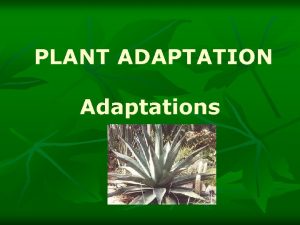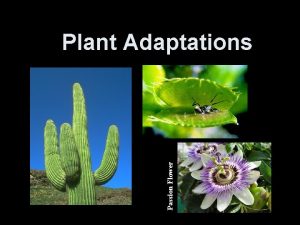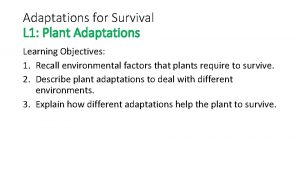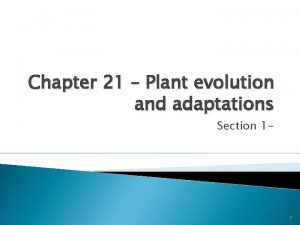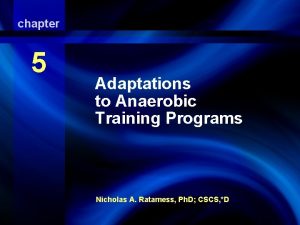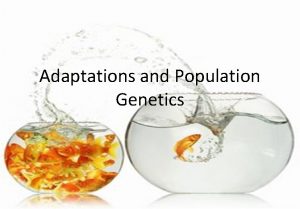Chapter 21 1 Plant evolution and Adaptations Plant




































- Slides: 36

Chapter 21. 1 Plant evolution and Adaptations

Plant Characteristics Multicellular Autotrophic Eukaryotes Tissues and organs

Green Algae to Plants Scientists think modern plants may have evolved from Green Algae because of similar characteristics…

I Spy… What are the differences between these two Autotrophs? Green Algae Giant Redwood

Similarities of Plants and Algae Cell walls w/ Cellulose Same type of Chlorophyll Food stored as starch Enzymes in vesicles Similar genes in r. RNA Cell division w/ cell plate Similar but not the same

What do you think plants needed to adapt to life on land? A: Bones of course B: Reproduce by air and land… not water C: Fed Ex sends weekly care packages of water D: Wet suit… the air dries me out!

4 Plant Adaptations to Land Cuticle – Prevents drying out – Barrier to microbes

4 Plant Adaptations to Land Stomata – Allows for gas exchange

4 Plant Adaptations to Land Vascular tissue – Allows for movement of nutrients & water – Provides support

4 Plant Adaptations to Land Seeds – Survive harsh conditions – Food for developing embryo

Alteration of Generations Gametophyte produces haploid (n) gametes Sporophyte produces diploid (2 n) spores

Kingdom Plantae Nonvascular 1. 2. 3. Bryophytes- Moss Antherocerophytes- Hornworts Hepaticophytes- Liverworts Vascular without seeds 4. 5. 6. Lycophytes- Club mosses Spenophytes - Horsetails Pterophytes- Ferns Vascular with seeds 7. 8. 9. 10. 11. Cycadophytes- Cycads of sago plants Gnetophytes- Joint firs Ginkophytes- Ginkgoes Coniferophytes- Pines Anthophytes- Flowering plants

Chapter 21. 2 Nonvascular Plants

Nonvascular Plants Small Requires water Found in damp, shady areas

3 Divisions of Nonvascular plants Bryophyta- Moss Anthocerophyta- Hornworts Hepaticophyta- Liverworts Gametophyte is dominant

Division Bryophyta One cell thick leaf-like structures Rhizoids for anchorage Peat – used for fuel, retain moisture for gardeners Moss

Division Anthocerophyta One large chloroplast in each cell May have symbiotic relationship with cyanobacteria Hornwort

Division Hepaticophyta Unicellular rhizoids Thallose – fleshy, lobed structures Leafy – stems with thin leaf-like structures in rows liverwort

Thallose vs Leafy Two kinds of Liverwort Thallose Leafy

Chapter 21. 3 Seedless Vascular Plants

Seedless Vascular Plants Have Vascular Tissue Larger than Non-vascular Better adapted to drier environments Strobilus – spore bearing structure Sporophyte is dominant Division Lycophyta and Pterophyta (Sphenophyta)

Division Lycophyta Sporophyte is dominant Have roots, stems, and small, scaly leaf-like structures Some are epiphytes – lives anchored to another plant or object Club mosses

Division Pterophyta/Sphenophyta Horsetails or scouring rushes Cell walls of silica Only one genus = Equisetum Horsetails - Equisetum

Division Pterophyta Thick underground stem – rhizome (food storage) Fronds with sporangia underneath (sorus) ferns

Chapter 21. 4 Vascular Seed Plants

Vascular Seed plants Vascular tissue Cotyledons – food storage for embryo Seed dispersal – Wind, water, animal Sporophyte- dominant life cycle – Male gametophyte: Pollen – Female gameophyte: Egg Produce Seeds – Gymnosperms: “Naked Seed” without fruit. Ex: Pines, fir trees – Angiosperms: Seeds are part of the fruit Ex: Apples, peaches, blackberries

5 Divisions of Seed Plants Division Cycadophyta Division Gnetophyta Division Ginkgophyta Division Coniferophyta Division Anthophyta

Division Cycadophyta Separate male and female plants Found in tropical and subtropical environments Cycad

Division Gnetophyta Live 1500 – 2000 years 3 genera – Ephedra – bush Ephedrine medicine Found in US – Gnetum - trees & climbing vines – Welwitschia – two large leaves

Division Ginkophyta One living species: – Ginkgo biloba Fan shaped leaves Separate male and female trees Tolerate pollution

Division Coniferophyta Shrubs and trees Economically useful – Lumber, paper, turpentine Male and female cones on same tree Scalelike leaves with cutin Evergreen – lose leaves throughout the year

Leaves Evergreen- Keep some green leaves all year Deciduous- Lose leaves once a year

Division Anthophyta Flowering plants

Angiosperms

2 kinds of angiosperms Monocots – One seed leaf – Parallel veins in leaves – Flowers in multiples of 3 s Monocot examples: grasses, orchids, lilies, and palms Dicots/Eudicots – Two seed leaves – Netted veins in leaves – Flowers in multiples of 4 s or 5 s Dicot examples: maples, oaks, sycamores Eudicot examples: trees, shrubs, flowering plants

Life span of plants Annual - live for one year – Most are herbaceous (green stems) – Have drought resistant seeds – Examples: corn, wheat, peas, and squash Biennial - live for two years – Have large storage roots – Produce flowers in the second year – Examples: carrots, beets, and turnips Perennial – live for many years – Usually flower once a year – Examples: maples and oaks
 Chapter 21 section 1 plant evolution and adaptations
Chapter 21 section 1 plant evolution and adaptations Anthocerophytes
Anthocerophytes Hepaticophytes
Hepaticophytes Chapter 25 plant responses and adaptations answer key
Chapter 25 plant responses and adaptations answer key Chapter 25 plant responses and adaptations
Chapter 25 plant responses and adaptations Plant evolution and classification
Plant evolution and classification Bougainvillea adaptations
Bougainvillea adaptations Precipitation of temperate deciduous forest
Precipitation of temperate deciduous forest Grassland
Grassland Prairie plant adaptations
Prairie plant adaptations Structural adaptation plants
Structural adaptation plants Salt marsh plant adaptations
Salt marsh plant adaptations Deciduous forest adaptations
Deciduous forest adaptations Plant adaptations in temperate grasslands
Plant adaptations in temperate grasslands Tropical rainforest plants adaptations
Tropical rainforest plants adaptations Temperate forest animals adaptations
Temperate forest animals adaptations Temperate grasslands plant adaptations
Temperate grasslands plant adaptations Mbg net
Mbg net Temperate deciduous forest plant adaptations
Temperate deciduous forest plant adaptations Canadian forest food chain
Canadian forest food chain Four main groups of plants
Four main groups of plants Prenatal care and adaptations to pregnancy
Prenatal care and adaptations to pregnancy Chapter 4 prenatal care and adaptations to pregnancy
Chapter 4 prenatal care and adaptations to pregnancy Tronsmo plant pathology and plant diseases download
Tronsmo plant pathology and plant diseases download Tronsmo plant pathology and plant diseases download
Tronsmo plant pathology and plant diseases download Tronsmo plant pathology and plant diseases download
Tronsmo plant pathology and plant diseases download Organism
Organism Chapter 18 genomes and their evolution
Chapter 18 genomes and their evolution Chapter 5 evolution and community ecology
Chapter 5 evolution and community ecology Chapter 5 evolution and community ecology
Chapter 5 evolution and community ecology Chapter 4 biodiversity and evolution
Chapter 4 biodiversity and evolution Tiburonia granrojo
Tiburonia granrojo Chapter 14 evolution a history and a process
Chapter 14 evolution a history and a process Chapter 20 postpartum adaptations
Chapter 20 postpartum adaptations Introduction in plant breeding
Introduction in plant breeding Plant breeding for disease resistance
Plant breeding for disease resistance Plant introduction in plant breeding
Plant introduction in plant breeding
